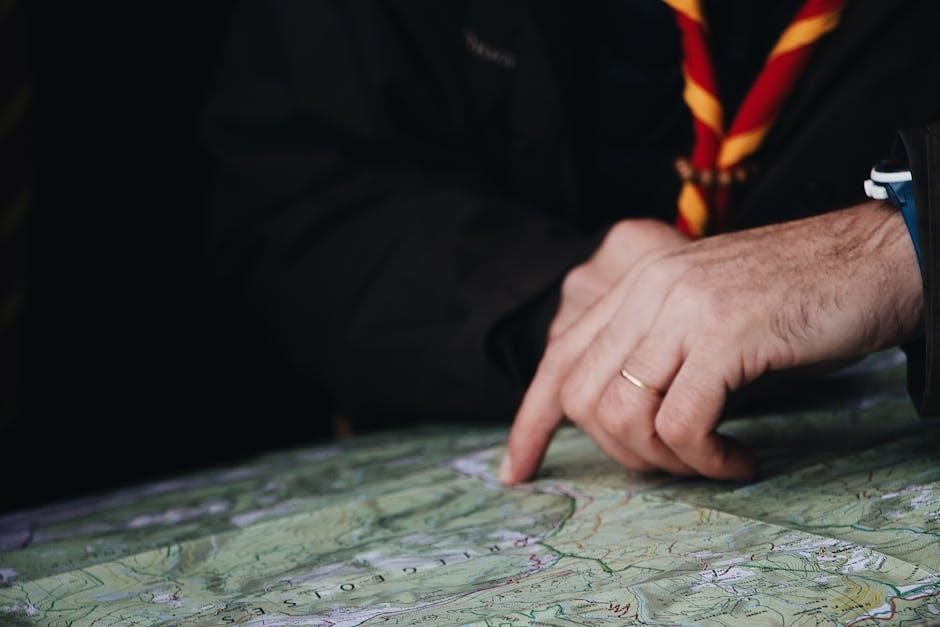Guiding Hand 5e is a 1st-level divination spell from Unearthed Arcana‚ creating a spectral hand that directs you to a specified landmark‚ aiding navigation and exploration with convenience.
1.1 Overview of the Spell
Guiding Hand 5e is a 1st-level divination (ritual) spell creating a spectral hand that guides you to a specified landmark. It appears as a Tiny‚ incorporeal hand of shimmering light‚ moving toward the designated location while maintaining a 5-foot distance from you. The spell lasts up to 8 hours with concentration but disappears if you teleport or change planes. Introduced in Unearthed Arcana‚ it’s a versatile tool for navigation and exploration in various campaigns.
1.2 Source and Publication
The Guiding Hand spell was first introduced in the Unearthed Arcana: Starter Spells playtest material‚ published by Wizards of the Coast. It is available for playtesting‚ offering insights into its potential as a divination spell. While not officially part of the core 5e rules‚ it provides an innovative approach to navigation and exploration‚ making it a unique addition for classes like the Bard‚ Cleric‚ Druid‚ and Wizard. Its experimental status encourages feedback from players and Dungeon Masters alike.
1.3 Spell Type and Level
Guiding Hand is a 1st-level divination spell‚ classified as a ritual‚ emphasizing its utility in providing guidance through supernatural means. Its low level ensures accessibility to early-stage characters‚ offering a practical tool for navigation and exploration. As a divination spell‚ it relies on insight and directional awareness‚ making it a valuable asset for classes like the Bard‚ Cleric‚ Druid‚ and Wizard‚ who often seek to uncover or interpret information in their adventures.

Spell Details and Mechanics
Guiding Hand 5e involves creating a spectral hand that guides toward a specified landmark‚ functioning through concentration and specific components‚ with defined duration and range parameters.
2.1 Casting Time and Range
Guiding Hand 5e requires a casting time of 1 minute‚ allowing the spell to be prepared with careful intent. The spell’s range is limited to 5 feet‚ meaning the spectral hand appears within this proximity. Once cast‚ the hand materializes in an unoccupied space‚ initiating its guidance toward the specified landmark. The short range ensures the hand remains nearby‚ providing clear directional cues without ambiguity. This setup balances convenience with strategic placement‚ making it practical for navigation in various settings.
2.2 Components and Duration
Guiding Hand 5e requires verbal (V) and somatic (S) components to cast‚ invoking the spectral hand’s manifestation; The spell lasts for up to 8 hours‚ maintained through concentration‚ ensuring continuous guidance. However‚ the spell ends prematurely if the caster teleports or transitions to a different plane of existence. This duration and component structure highlight the spell’s reliance on focus and physical gestures‚ balancing its utility with manageable upkeep for adventurers seeking extended navigational assistance in their journeys.
2.4 Spell Description and Functionality
The spell creates a Tiny‚ incorporeal hand of shimmering light that appears in an unoccupied space within range. This spectral hand leads the caster to a specified landmark by moving away when approached‚ maintaining a 5-foot distance. If the caster does not move toward it‚ the hand beckons periodically‚ ensuring guidance. The hand disappears if the caster teleports or transitions to another plane‚ emphasizing its role as a steadfast‚ albeit temporary‚ navigational aid in the same plane of existence.

How Guiding Hand Works
Guiding Hand creates a spectral hand of light that leads the caster to a named landmark. It moves away when approached‚ maintaining a 5-foot distance‚ and disappears if the caster teleports or changes planes.
3.1 Creation of the Incorporeal Hand
The spell conjures a Tiny‚ incorporeal hand of shimmering light in an unoccupied space within 5 feet. This spectral hand is visible and exists for the duration‚ serving as a guide. It remains until the caster teleports‚ changes planes‚ or the concentration is broken. The hand’s appearance is ethereal and non-interactable‚ solely functioning to direct the caster toward the designated landmark.
3.2 Landmark Specification
Upon casting‚ the caster must name a major landmark on the same plane‚ such as a city‚ mountain‚ or castle. The site must have been previously visited and mapped by someone‚ ensuring the hand’s ability to guide effectively. This requirement ensures the landmark is identifiable within the spell’s framework‚ allowing the hand to navigate towards it accurately. The specificity of the landmark is crucial for the spell’s functionality and success in providing clear direction.
3;3 Movement and Behavior of the Hand
The incorporeal hand moves away when approached‚ maintaining a 5-foot distance‚ and directs toward the specified landmark. If not followed‚ it remains stationary‚ beckoning every 1d4 minutes. The hand disappears if the caster teleports or changes planes‚ ensuring it only functions within the same plane of existence. Its behavior is consistent‚ providing clear guidance without deviation‚ making it a reliable tool for navigation and exploration in various adventuring scenarios.

Limitations of the Spell
Guiding Hand disappears if the caster teleports‚ changes planes‚ or loses concentration. It requires a known‚ mapped landmark and functions only on the same plane‚ limiting its versatility.
4.1 Disappearance Conditions
The Guiding Hand vanishes under specific circumstances‚ ensuring its limitations are clear. If the caster teleports or moves to another plane of existence‚ the hand immediately disappears. Additionally‚ losing concentration‚ whether due to injury‚ capture‚ or failing a concentration check‚ causes the hand to dissipate. These conditions prevent misuse and ensure the spell remains balanced. They also emphasize the need for careful planning and continuous focus when utilizing this ability in gameplay.
4.2 Plane of Existence Restrictions
The Guiding Hand spell is confined to a single plane of existence. It cannot function across different planes‚ and the hand disappears instantly if the caster travels to another plane. The named landmark must also exist on the same plane as the caster at the time of casting. This restriction ensures the spell’s utility is grounded in the current campaign setting‚ preventing its misuse across dimensional boundaries. It also highlights the spell’s design as a practical navigation tool within specific environments.
4.3 Concentration Requirements
Guiding Hand requires the caster to maintain concentration to sustain the spectral hand. If the caster loses concentration‚ the spell ends immediately. This can happen due to taking damage‚ casting another spell that requires concentration‚ or being interrupted during the spell’s duration. The hand’s persistence relies entirely on the caster’s focus‚ making it less reliable in chaotic or high-stress situations. This mechanic balances the spell’s utility‚ ensuring it remains a practical yet fragile tool for navigation and exploration.

Strategic Uses of Guiding Hand
Guiding Hand excels in navigation‚ exploration‚ and subtle combat support. It aids in tracking locations‚ avoiding hazards‚ and providing discreet guidance‚ enhancing both utility and versatility in various scenarios.
5.1 Navigation and Exploration
Guiding Hand is invaluable for navigation‚ creating a spectral hand that leads to a specified landmark. Ideal for exploring vast terrains or unknown dungeons‚ it ensures parties stay on course‚ reducing the risk of getting lost. The hand’s persistent guidance allows adventurers to focus on their surroundings‚ making it a reliable tool for both overland journeys and intricate maze-like structures‚ enhancing exploration efficiency significantly.
5.2 Combat Applications
While primarily a utility spell‚ Guiding Hand offers subtle combat advantages. The spectral hand can guide allies to strategic positions‚ highlight enemy movements‚ or pinpoint weaknesses. It can also assist in directing summons or marking objectives without breaking concentration. However‚ its limited range and reliance on landmarks make it less effective in chaotic combat scenarios‚ though it excels in coordinated‚ strategic battles where positioning is key.
5.3 Role-Playing Opportunities
Guiding Hand offers rich role-playing potential‚ allowing characters to express their personality through its use. Clerics might view it as divine guidance‚ while wizards see it as a practical tool. It can serve as a mysterious beacon during explorations‚ fostering intrigue or wonder. The spell’s reliance on known landmarks also ties characters to the game’s lore‚ encouraging storytelling and world-building. Its subtle yet versatile nature makes it a valuable asset for immersive role-playing experiences at every table.

Comparison with Similar Spells
Guiding Hand stands out among divination spells due to its unique navigation focus‚ differing from Guidance and Mage Hand in both function and application‚ offering distinct utility in exploration scenarios.
6.1 Guidance vs. Guiding Hand
Guidance and Guiding Hand are both 1st-level spells but differ in purpose. Guidance is an enchantment that grants a creature advantage on one ability check of your choice‚ lasting up to 10 minutes. In contrast‚ Guiding Hand is a divination spell that creates a spectral hand guiding you to a specific landmark‚ lasting up to 8 hours with concentration. While Guidance enhances ability checks‚ Guiding Hand focuses on navigation and exploration‚ making them distinct in utility and application.
6.2 Mage Hand vs. Guiding Hand
Mage Hand and Guiding Hand share similarities as spectral hands but differ in function. Mage Hand is a cantrip that summons a hand to manipulate objects‚ lasting until dismissed‚ while Guiding Hand is a 1st-level spell that creates a hand guiding you to a landmark‚ requiring concentration up to 8 hours. Mage Hand focuses on object interaction‚ whereas Guiding Hand aids navigation‚ making them unique tools for different tasks in gameplay.
6.3 Other Divination Spells
Guiding Hand stands alongside other divination spells like Augury and Portent‚ each offering unique utility. While Guiding Hand aids navigation‚ Augury provides omens for decision-making‚ and Portent reveals future events. These spells collectively enhance a caster’s ability to gather information and make informed choices‚ making them invaluable in various campaign scenarios for strategic planning and problem-solving. Together‚ they exemplify the versatility of the divination school in D&D 5e.

Synergy with Other Abilities
Guiding Hand complements exploration spells and class features‚ enhancing navigation and utility. It seamlessly integrates with abilities like Pass Without Trace and Find Steed‚ boosting versatility in campaigns.
7.1 Combination with Exploration Spells
Guiding Hand enhances exploration by pairing with spells like Find Steed and Pass Without Trace. It directs mounts or stealthy parties efficiently‚ while Arcane Eye provides real-time surveillance‚ ensuring precise navigation. This synergy boosts adventurers’ effectiveness in uncharted territories‚ combining guidance with mobility and stealth for seamless exploration.
7.2 Synergy with Class Features
Guiding Hand complements class features like Cleric’s Domain Abilities and Bard’s Jack of All Trades. For Clerics‚ it enhances navigation during quests tied to their domain. Bards can use it to scout ahead‚ leveraging their expertise. Druids benefit in wilderness settings‚ while Wizards can combine it with divination spells for strategic planning. This synergy amplifies each class’s unique strengths‚ creating versatile and dynamic gameplay opportunities.
7.3 Interaction with Magic Items
Guiding Hand can be enhanced by magic items that extend spell duration or improve concentration. Items like Ring of Spell Storing or Cloak of Invisibility can complement its utility. Although no direct interactions exist‚ items that boost Wisdom or Dexterity scores indirectly aid spellcasting ability. Additionally‚ items granting resistance to distractions can help maintain concentration‚ ensuring the hand guides effectively. This synergy enhances the spell’s reliability and versatility in diverse adventuring scenarios.

Spell Lists and Availability
Guiding Hand is a 1st-level divination spell available to Bards‚ Clerics‚ Druids‚ and Wizards. It is published in Unearthed Arcana: Starter Spells for playtesting purposes.
8.1 Classes That Can Cast Guiding Hand
Guiding Hand is available to Bards‚ Clerics‚ Druids‚ and Wizards. As a 1st-level divination spell from Unearthed Arcana: Starter Spells‚ it requires DM approval for use in official campaigns.
8.2 Spell Lists and Domains
Guiding Hand appears in the spell lists for Bards‚ Clerics‚ Druids‚ and Wizards. For Clerics‚ it aligns with the Knowledge domain’s focus on exploration and divination. The spell is categorized under divination magic‚ emphasizing its utility in navigation and discovery. While not part of the official SRD‚ it is included in the Unearthed Arcana: Starter Spells playtest material‚ requiring DM approval for use in official campaigns. Its ritual tag makes it versatile for preparation and casting.
8.3 Unearthed Arcana and Playtesting
Guiding Hand was introduced in the Unearthed Arcana: Starter Spells playtest material‚ released for community feedback. This spell is not officially balanced yet‚ so DMs must approve its use in campaigns. The UA document presents it as a 1st-level divination (ritual) spell‚ encouraging playtesters to experiment with its mechanics and provide insights. Wizards of the Coast may revise or finalize it based on player feedback‚ ensuring it fits seamlessly into 5e’s balanced framework. Playtesting helps refine its utility and potential impacts on gameplay.

Optimization and Tips
Optimize Guiding Hand by using it for long journeys or unknown territories. Maximize its duration by maintaining concentration‚ ensuring uninterrupted guidance for up to 8 hours seamlessly.
9.1 When to Use Guiding Hand
Use Guiding Hand during exploration to navigate unfamiliar territories or locate distant landmarks. It excels in dungeons‚ forests‚ or vast open areas where direction is unclear. Cast it before long journeys or when venturing into uncharted regions. The spell is particularly useful for guiding allies or marking paths in complex environments. Additionally‚ it can enhance role-playing by helping NPCs or serving as a divine signpost in your campaign‚ adding depth to your storytelling.
9.2 Maximizing Spell Duration
To maximize the duration of Guiding Hand‚ maintain concentration and avoid distractions. Cast the spell in a calm environment and minimize interruptions. Since it lasts up to 8 hours‚ use it strategically before extended journeys or explorations. Avoid engaging in combat or casting other spells requiring concentration to prevent the spell from ending prematurely. Ensuring a clear path to the landmark also helps the hand function effectively‚ making your travel smoother and more efficient.
9.3 Creative Uses in Campaigns
Beyond navigation‚ Guiding Hand offers creative storytelling opportunities. DMs can use it to lead players to hidden plot points or secrets‚ enhancing immersion. Players can employ the spell to mark important locations or guide allies subtly. In roleplay‚ the hand can serve as a divine omen or mysterious guide‚ enriching character backgrounds. Its versatility makes it a valuable tool for both exploration and narrative-driven gameplay‚ encouraging innovative uses that deepen the campaign’s lore and engagement.

FAQ and Common Questions
Frequently asked questions about Guiding Hand include its functionality across planes‚ concentration requirements‚ and combat usability‚ ensuring clarity on its mechanics and applications in various scenarios.
10.1 Can Guiding Hand Work Across Planes?
The Guiding Hand spell does not function across different planes of existence. If the caster teleports or travels to another plane‚ the hand disappears immediately. This limitation ensures the spell operates within the same plane‚ maintaining its purpose as a navigational aid. Therefore‚ it is not suitable for interplanar travel or guidance‚ restricting its use to a single plane at a time effectively.
10.2 How Does Concentration Affect the Spell?
Concentration is crucial for maintaining the Guiding Hand spell‚ as it requires sustained focus. If the caster’s concentration is broken‚ the spell ends‚ and the hand disappears. This emphasizes the need for the caster to remain attentive and not engage in activities that could disrupt their focus‚ ensuring the spell’s duration lasts up to its maximum potential of 8 hours effectively without interruption or loss of control.
10.3 Can the Hand Be Used in Combat?
While the Guiding Hand spell is primarily designed for navigation‚ its potential in combat is limited. The hand cannot interact with objects or enemies‚ nor can it deal damage. However‚ it can indirectly aid by guiding allies to strategic positions or providing tactical information. This subtle utility makes it a versatile tool‚ though not a direct combat asset‚ allowing for creative problem-solving in critical situations without violating its core magical constraints or purpose.
Guiding Hand 5e offers a unique blend of utility and simplicity‚ making it a valuable tool for navigation and exploration in various campaign settings‚ with potential for creative applications.
11.1 Final Thoughts on the Spell
Guiding Hand 5e is a versatile and reliable spell that excels in navigation and exploration. Its simplicity and utility make it a valuable addition to any caster’s toolkit. While it may not excel in combat‚ its ability to provide direction and clarity in unfamiliar territories makes it indispensable for adventurers. Its reliance on prior knowledge of landmarks is a minor limitation‚ but its overall utility shines in exploration-heavy campaigns or survival scenarios‚ offering creative opportunities for both players and DMs alike.
11.2 Value in Different Campaigns
Guiding Hand 5e offers exceptional value in exploration-focused campaigns‚ where navigation is key. In survival or wilderness settings‚ its ability to lead to known landmarks is invaluable. It also enhances role-playing by aiding lost characters or guiding allies. While less impactful in combat-heavy campaigns‚ its utility in traversal scenarios makes it a standout choice for clerics‚ druids‚ and bards seeking to support their party. Its versatility ensures it remains a useful tool across diverse gameplay narratives and objectives.
11.3 Potential Future Changes
As Guiding Hand 5e is part of Unearthed Arcana‚ it remains a playtest spell subject to balance adjustments. Future updates could refine its mechanics‚ such as extending its range or tweaking landmark requirements. Clarifications on inter-planar functionality or concentration rules may also emerge. Wizards of the Coast might adjust its spell list availability or duration based on feedback. While its core utility is unlikely to change‚ minor tweaks could enhance its versatility or address potential exploits‚ ensuring it remains a viable option in diverse campaign settings.
